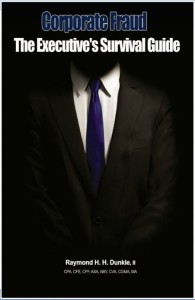Corporate Fraud: The Executive’s Survival Guide (to order your copy, contact us here).
Foreword
– Samuel Johnson
Fraud is defined by Black’s Law Dictionary, 5th edition, as “All multifarious means which human ingenuity can devise, and which are resorted to by one individual to get an advantage over another by false suggestions or suppression of the truth. It includes all surprises, tricks, cunning or dissembling (disguising, concealing), and any unfair way which another is cheated.” Simply put, fraud is lying for one’s own gain at the expense of another.
There are three factors that, when existing together, frequently lead to fraudulent behavior: pressure, opportunity, and rationalization. These factors comprise what is known as the fraud triangle. Pressure is the perceived need of the fraudster, which can range anywhere from meeting basic needs to keeping up with the Joneses. Opportunity is the perceived method by which the fraudster can commit the fraud without being caught and creating a new and potentially worse problem. Rationalization is the justification the fraudster makes to himself when committing the fraud. The fraudster may think he is underpaid, has no other choice, is only borrowing the money, or his employer has it coming.
While we do not address the need and rationalization components of the fraud triangle specifically in this book, the reader will find useful tactics for battling the potential fraudster’s perception of the company and his ability to engage in fraudulent behavior. Though no one can prevent all fraud, a great deal of progress can be made with the right training, education, and prevention programs in place.
Fraud, by its nature, involves falsehood, trickery and deception. Those who commit fraud attempt to conceal their acts so as to escape detection and its consequences. Concealment may involve forgery, alteration, falsification, or destruction of records; use of pseudonyms, false identities, and agents of ownership; maintenance of secret bank accounts or money laundering as a means of converting stolen assets; complex series of transactions engaged in solely to deceive, confuse, or conceal the truth; lies, omissions and intimidation; and collusion.
One of the main challenges with fraud is that just as we uncover the methods fraudsters are using to perpetuate the frauds that happened yesterday, the fraudsters are devising new schemes to implement today. Keeping up with the deceit, the money trail, and the co-conspirators is no simple task. With this book, we arm the reader with a front line of defense. In today’s digital, highly-connected age, fraud is increasingly easier not only to perpetuate but to innovate. Fortunately, many low-tech prevention measures stand the test of time and can provide meaningful barriers to would-be fraudsters.
Inside this book are tools not only for detecting fraud, but to deter and prevent in the first place. As the Association of Certified Fraud Examiners (ACFE) states in its 2014 Report to the Nations on Occupational Fraud and Abuse publication, “Clearly the best way to combat fraud is to educate anyone engaged in fighting fraud on how to effectively prevent, detect and investigate it.”
In the same publication, the ACFE also reports that nearly one-third of the frauds represented in the annual survey were marked by a clear lack of internal controls and approximately one-fifth were marked by lack of management review. Other weaknesses listed as contributing to fraud were an override of existing internal controls, poor tone at the top, lack of competent personnel in oversight roles, among others.
What we will take our readers through in the following pages is gaining an understanding of the controls, methods, and systems to put into place for fraud prevention, as well as what options are available once a fraud is suspected or discovered.
Looking for an independent ethics hotline service provider? We can help!
